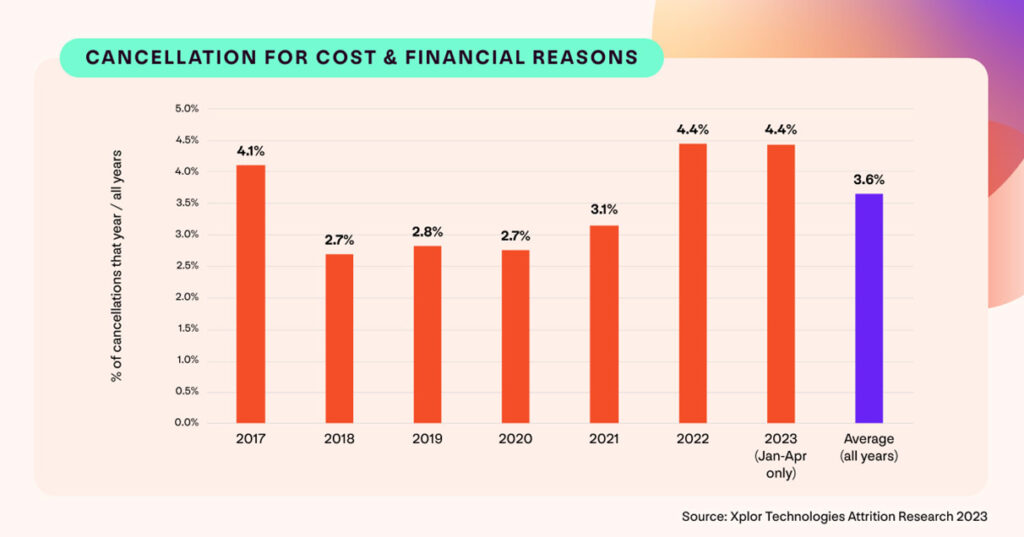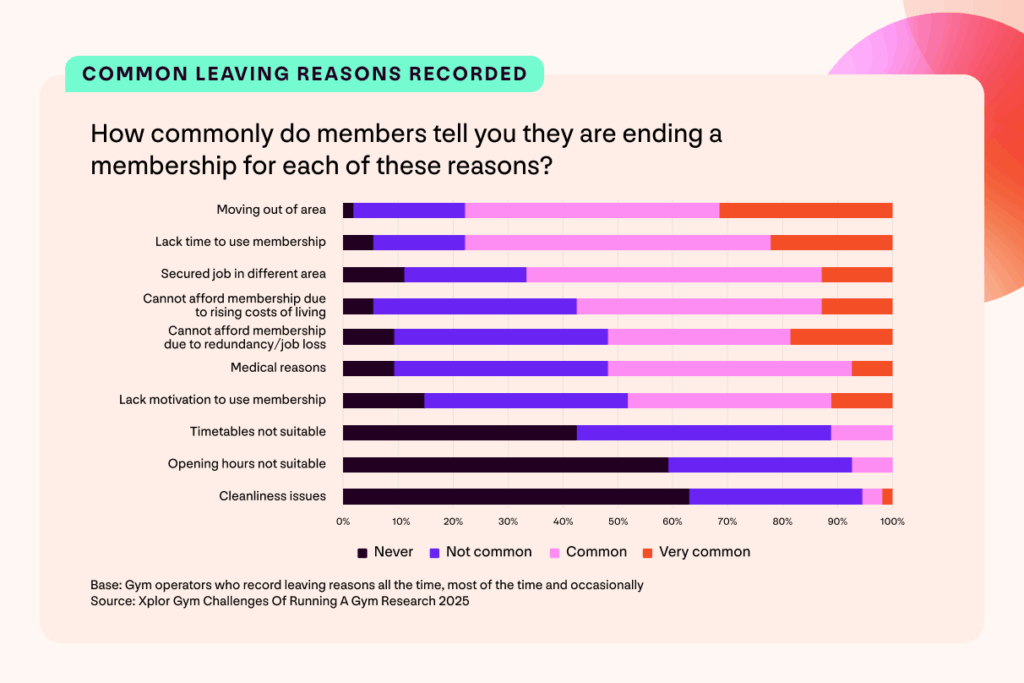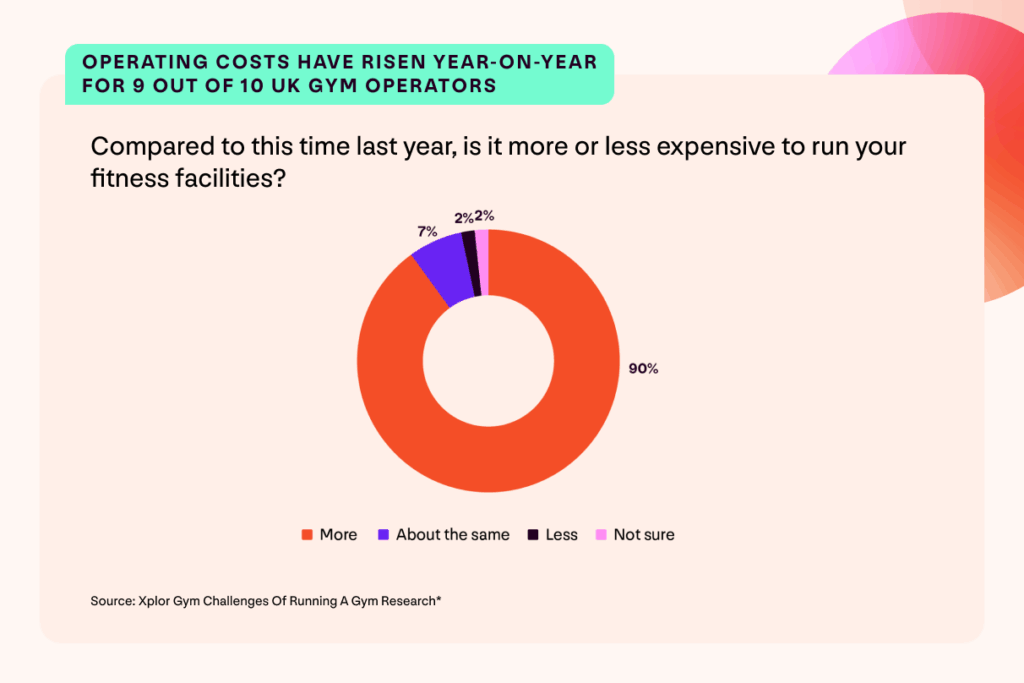The cost of living has risen over the last few years, and this has impacted gym memberships. Find out whether members are cancelling due to cost and financial reasons. Plus, understand how gym owners and operators have been impacted.
The rising cost of living has been a hot topic of conversation since late-2021. And most have been impacted by increased costs of some sort.
Some members are choosing to cancel (or change) their gym membership due to the impact of high costs on personal finances.
As a gym operator, it’s important to understand the true impact of cost of living on your members and your business, then react appropriately. Amidst rising costs there are positives for the fitness industry.
Let’s get stuck in!
Power up your business & stay in the know
The rising cost of living
Since late-2021, the cost of living has increased significantly in the UK and Ireland. Consumer goods and services prices (inflation) increased at the fastest rate in 4 decades in the year to October 2022. Inflation peaked at 9.6%.
Inflation dropped to 2.6% in September 2024. But has risen back up to 3.8% as of September 2025.
Public opinion research conducted by the Office for National Statistics between 3 and 28 September 2025, found that more than 88% of adults feel cost of living is one of the most important issues facing the UK today.
Similarly, recent YouGov research found that:
- 56% of Britons have been affected by cost-of-living pressures
- 40% have made cuts to usual spending and expect to make further cuts
- 21% have been able to maintain usual spending but expect to have to make cuts soon
- 82% find prices in the shops are rising faster than their income
Does this mean consumers are cutting spend on gym memberships?
How is cost of living impacting gym memberships?
Consumers are cost-conscious when it comes to spending on gym memberships and fitness. But there are positive signs that many are prioritising spending on fitness, viewing it as an essential not a luxury.
Have members cancelled due to cost?
YouGov research found that 8% of Brits said they’d been forced to make cutbacks to spend on gym memberships due to the cost of living. And of those forced to make cutbacks:
- 60% had stopped spending money on this altogether
- 20% had reduced the amount spent by switching to a cheaper alternative
- 7% had switched to a pay-as-you-go version
Xplor Gym’s Winning The War On Attrition research found that 4.4% of those who cancelled a membership in 2022 and early-2023 did so for cost or financial reasons.

This is a little lower than YouGov’s research suggests. Yet, it’s higher than the overall average in previous years.
2022 and early-2023 show the highest cancellations for cost and financial reasons since 2017. And 2017 was the year that saw lower than usual consumer spending due to stagnant wages and increased inflation following the 2016 Brexit vote.
The attrition research also found that 52% of former members quit the gym quietly. These members either:
- Failed to share a leaving reason when cancelling their gym membership
- Cancelled their payment directly with their bank
- Or experienced a payment failure
It’s likely that some of these quiet quitters left the gym as they were struggling with high living costs. Finances can be a tough topic. So, some will prefer not to tell you that they are struggling.
Are members still cancelling due to cost?
ukactive found that cost is a barrier to joining a gym for 68% of non-members. While these consumers are not technically cancelling due to cost, this data does show how cost-conscious consumers are.
It’s common to hear members are cancelling due to cost-of-living pressures
The 2025 Challenges Of Running A Gym Research found that 90% of UK gym operators surveyed at least occasionally record reasons why members leave.
57% commonly or very commonly hear members cannot afford to stay due to the rising cost of living. Similarly, 52% commonly or very commonly hear members cannot afford to stay due to redundancy or job loss.

This suggests that some members are still leaving due to cost-of-living pressures.
Many businesses are impacted by payment failures due to insufficient funds
Similarly, the 2025 Challenges Of Running A Gym Research found that of UK gym operators who use Direct Debits to collect membership payments, 96% say payment failures due to insufficient funds have an impact on business.

ONS data shows that on average in the period from January to August 2025, 5.79% of Direct Debits processed for fitness facilities failed due to insufficient funds. This compared to 5.38% in the same period the year before.
Insufficient funds can suggest financial difficulties, indicating gymgoers are struggling with payments a little more in 2025 compared to 2024.
Sometimes, these failures ultimately lead to a cancelled membership, leaving operators in the dark as to what’s happened.
To get a true understanding of the extent of cancellations due to cost, you need to create the right environment to encourage members to share this with you:
- Build a culture where gym member feedback is valued and members feel they can be honest with you
- Give members more control (consider giving them access to freeze or cancel digitally through your gym membership software without feeling confronted or uncomfortable having to speak to someone)
- Take an effective approach to managing membership payments to reduce failures
There are signs cost of living is having a limited impact on gym memberships
While some members do appear to have cancelled due to the cost of living, there are plenty of positive signs that many are prioritising their gym membership investment:
- ukactive reports that the number of members at UK fitness facilities have increased from 9.9 million in 2022 to 11.5 million in 2024
- Leisure DB reports that the private sector has reached an all-time high achieving a penetration rate of 11.4% (compared to 10.9% in 2024) with 7.76 million members (up from 7.33 million in 2024)
- The Gym Group found that Gen Z are prioritising spending on health and fitness. 44% rank fitness as their first or second spending priority

Impact of higher costs on gyms & fitness clubs
“Although the devil is in the detail, let me suggest that the pandemic, inflation and higher energy costs will, in the long term, be seen to be good for the industry.”
David Minton, Founder of Leisure DB in the State of The UK Fitness Industry Report 2023
With rising costs for consumers, come rising costs for businesses too.
90% of UK gym operators report that operating costs have gone up compared to a year before.

Many clubs have had to adapt gym pricing strategies to offer new membership options. And to increase prices – 68% have increased prices since January 2024.

The 2025 edition of the State of The UK Fitness Industry Report from Leisure DB found that the cost of a membership at private gyms and fitness clubs has increased. The average cost of a gym membership in the UK is now £48.45 – up from £47.24 in 2024, £44.92 in 2023 and £42.99 in 2022.
While a portion of those who increased prices faced member cancellations, broadly higher costs have made higher fees more accepted, without impacting member numbers.
Low-cost brands (traditionally charging less than £25 a month) are now moving into the mid-market. And mid-market brands are moving into the premium category. While there’s a new super-premium category emerging.
How to increase gym membership prices (and keep members)
Go deeperFind out how to raise prices with minimal attrition. Improve profitability, protect your business, and charge what you deserve.
Get stuck in!The wrap up…
Signs are positive that the rise in prices and inflation is slowing. Yet, costs are still high, and wages have not yet caught up. That’s impacting consumer spending power.
Some members have been forced to quit the gym due to living costs. Yet, many have chosen to continue investing in a gym membership, understanding the value it brings to their fitness and wellbeing.
Gyms and fitness clubs have also been impacted by rising prices. Many have been forced to increase their membership prices (and offer new types of memberships to cater for different budgets). Overall, this has pushed up market value and has not impacted market penetration.
Tackle rising costs head on – grab your copy of 25 Ways To Boost Cashflow And Save Money.

by Megan Greenaway Customer Success Manager at Xplor Gym
-
First published: 10 November 2025
Written by: Megan Greenaway
